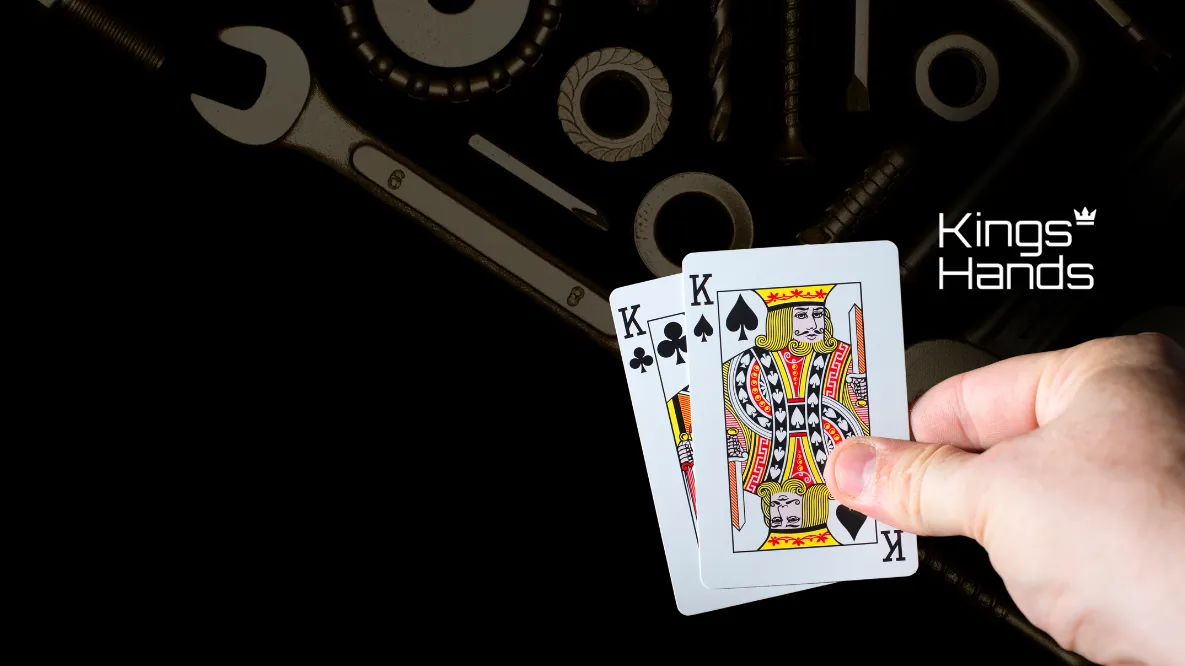Bluffing EV calculations are an important aspect of poker math that helps you determine the profitability of a bluff. So far, we’ve looked at calculations that determine whether or not it’s profitable to call a bet from your opponent, but a Bluffing EV calculation can help you determine whether or not a bluff is profitable.
In this article, we’ll be looking at exactly what EV is, why it’s important, and how you can use it in your game.
What Does EV Mean?
EV, or Expected Value, is a representation of the average value you’d gain or lose if a situation were to play out hundreds or thousands of times. While beginner players think in terms of outcome (whether or not they won the hand), good players think in terms of value; if their decision does not provide value in the long run, they know they’ve made a bad decision.
For example, if Player A bets $100 into a $100 pot on the turn, and Player B calls all-in for their last $100 with a flush draw. Player B makes their flush on the river and wins the $300 pot. Did they make a profitable decision?
If you ask a recreational player, they will likely tell you yes as Player B won the pot. However, a good player will know that Player B was not getting the right odds to call with their flush draw, and will lose money making that call in the long run.
Why Is EV Useful?
EV calculations are an important tool that helps you determine the profitability of all of your actions at the poker table. Running these calculations removes a good amount of the guesswork from your game, and allows you to get an understanding of whether or not your decision will be profitable in the long run.
It’s important that you think about decisions based on their expected value or long-term value rather than on their short-term outcome. If you’re a serious poker player, you can expect to rack up tens of thousands, or even hundreds of thousands of hands a year. In the course of your sessions, you’ll likely run into the same scenarios over and over again; if you think about these scenarios in isolation, you could be making big mistakes that will affect your win rate over the long term.
How Does Outright Bluffing EV Work?
Now that we understand why it’s useful to us, let’s see how the Bluffing EV calculation works. Below, we’ve written out the Bluffing EV calculation that you can use to determine whether or not your action will be profitable in the long run.
Bluffing EV = (Pot Size * Fold %) – (Bet Size * Call %)
Pot Size – What is the size of the pot before you make a bet?
Fold % – How often does your opponent fold?
Bet Size – How much do you bet?
Call % – How often does your opponent call?
One aspect of this calculation that separates it from the ones we’ve looked at previously is the level of guesswork required to fill in the variables. You’ll never know for certain how often you’ll win or how often you’ll lose, so it’s important that you use your hand-reading skills to determine these variables.
In fact, some players will run two Bluffing EV calcs in tough scenarios; one that represents the best-case scenario, and one that represents the worst-case scenario. By doing this, they get a sense of how profitable or unprofitable their decision will be in the most extreme cases, giving them a better idea of their average profitability.
To put all of this into context, let’s take a look at an example:
We’re on the river with ; the board reads – we’ve missed our big flop draw, and are left with 5-high on the river. After our opponent has check/called two streets, they’ve checked to us again on the river, and we need to determine how profitable a river bluff would be.
Given the action in the hand, we think our opponent likely has a strong hand, or a draw of their own that has missed. We think they will call around 65% of the time to our $60 river bluff and will fold 35% of the time.
Putting that into our Bluffing EV equation, we get the following answer:
Bluffing EV = ($100 * 0.35) – ($60 * 0.65)
Bluffing EV = ($35) – ($39) = -$4
As we can see, given our assumptions of the situation, making this bluff would have an expected value of -$4, which means we would lose money in the long run.
However, what if we bet $40 on the river instead of $60? Does that change anything, assuming that our opponent folds at the same rate? Let’s have a look.
Bluffing EV = ($100 * 0.35) – ($40 * 0.65)
Bluffing EV = ($35) – ($26) = $9
Just by reducing our bet size by $20, the expected value of our bluff rises from -$4 up to $9!
Similarly, the expected value of our bet will also change if we alter the fold percentages. Let’s see how profitable/unprofitable our $60 river bluff would be if our opponent folds 50% of the time rather than 35% of the time.
Bluffing EV = ($100 * 0.5) – ($60 * 0.5)
Bluffing EV = ($50) – ($30) = $20
So, if our opponent folds 15% more of the time, our value increases from -$4 up to $20!
This should highlight how important it is to be accurate with your variables, as even small differences can result in big differences in expected value.
Outright Bluffing EV In Action
Let’s take a look at a player using this expected value calculation in action. We join the late, great Doyle Brunson in a hand against Lex Veldhuis on High Stakes Poker. Lex has straddled to $2K and the action has folded around to Doyle in the big blind who calls the extra $1K with Qs7s. Lex raises to $11K with 9s2s, and Doyle makes the call.
They see a flop of 6s2d3h, which quickly checks through. The Jc hits the turn, and Doyle makes a bluff at it – betting $20.5K into $24K. Lex makes the call, and the two see the 4c hit the river, putting four to a straight on board.
Doyle has to decide whether or not he should bluff at this card with his queen-high, so he runs a quick EV calculation.
After making a big bet on the turn, Doyle wants to make a big bet on the river to continue his aggressive action, so decides on $60K as his bet size. Given Doyle’s reputation as a somewhat tight player and the fact that Lex checked back the flop, Doyle thinks that he will get a lot of folds from Lex. In this situation, it’s reasonable to think that Lex will fold the majority of the time, so we’ll give Lex a fold percentage of 60%.
Let’s take a look at the EV calculation given this assumption:
Bluffing EV = ($65,000 * 0.6) – ($60,000 * 0.4)
Bluffing EV = ($39,000) – ($24,000) = $15,000
Given the bet size and the assumed fold percentage, Doyle can see that this would be a profitable river bluff, so he pulls the trigger, putting Lex in a tough spot.
However, Lex digs deep and makes the call, winning a huge pot with just a pair of deuces.
It just goes to show, you can make all the right decisions in poker, and still end up on the losing end of things!
Outright Bluffing EV Test
Now that we understand how Bluffing EV works, let’s put your new knowledge to the test with a short test. You can find the answers at the bottom of the page.
Question 1
You have a 6-high busted flush draw on the river and want to bluff $5 into a $20 pot. You think your opponent will call 90% of the time. Is this a profitable bluff?
Question 2
You have king-high on the river and want to bet $100 into a $75 pot. You think that your opponent will fold 75% of the time. Is this a profitable bluff?
Question 3
You have a 9-high busted straight draw on the river and are torn between betting $30 or $70 into a $90 pot. You think your opponent will fold 55% of the time to the $70 bet, but only 35% of the time to the $30 bet. Which bluff is the most profitable?
Summary
Poker math such as Outright Bluffing EV calculations helps players remove the guesswork from their play and determine exactly how profitable their bluffs are. Without running these calculations, you would not know whether or not your bluff is profitable, making it hard to determine what the right decision should be.
However, the results of your calculations will heavily vary depending on your inputs, so make sure you’re as accurate as possible when determining how often your opponent will call or fold.
Answers:
Question 1 – This bluff is not profitable and has an expected value of -$2
Question 2 – This bluff is profitable and has an expected value of $31.25
Question 3 – The $70 bluff is the most profitable as it has an expected value of $18 compared to the $30 bet’s expected value of $12.





















